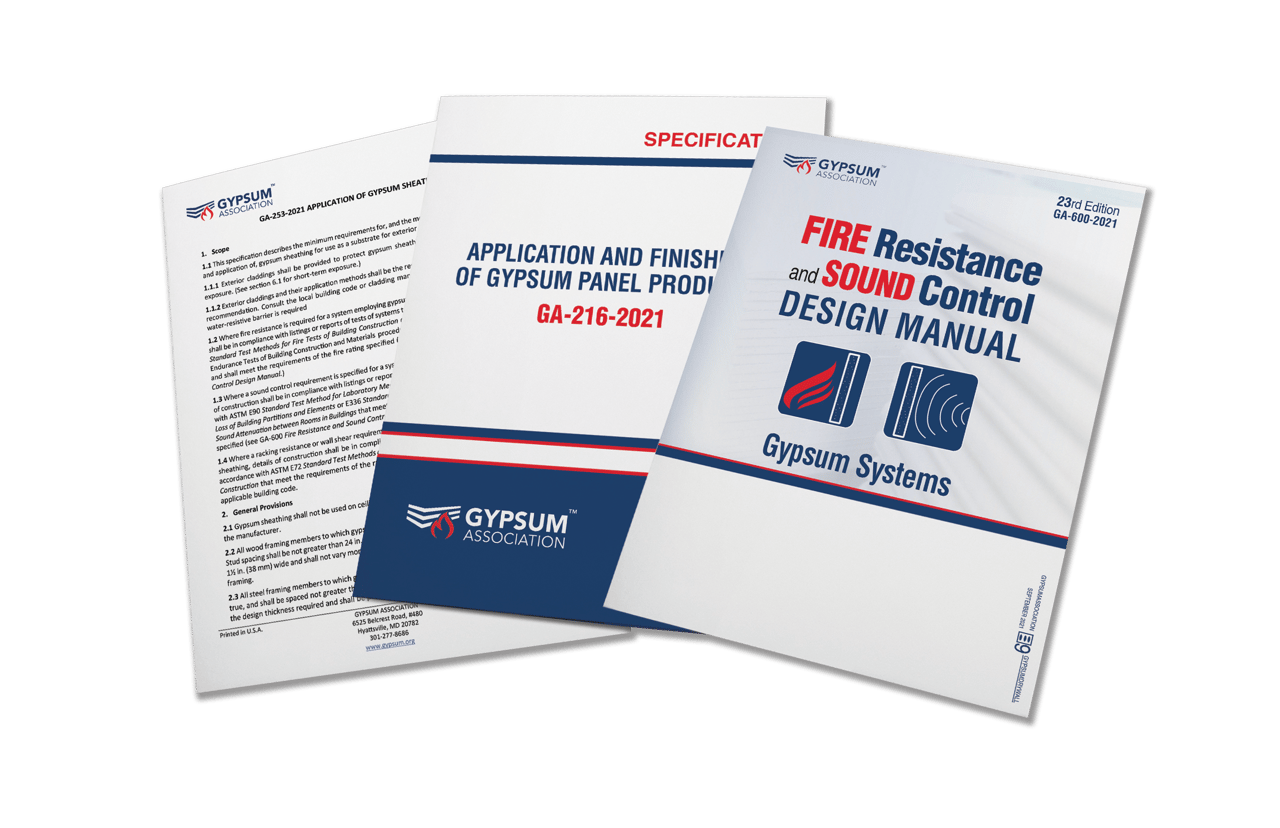
Susan
Hines
GA to Update All Code-Referenced Documents in 2021
The association will update all code-referenced documents, especially GA-600 as it is relied upon as a source document for fire-resistance and sound-control design.
Susan Hines
ALL THINGS GYPSUM
Every three years, in alignment with the building code cycle, the Gypsum Association issues new editions of the Association’s three code-referenced publications: GA-600 Fire Resistance and Sound Control Design Manual, GA-216 Application and Finishing of Gypsum Panel Products, and GA-253 Application of Gypsum Sheathing. The work of revising these important publications is undertaken by GA technical staff and members of the Building Code and Technical Committee, which is comprised of representatives from each of the association’s six member companies.
Maintaining and improving upon the GA’s Fire Resistance and Sound Control Design Manual is crucial because the manual is referenced by the ICC’s International Building Code, and National Fire Protection Agency’s National Fire Codes. Many state and local jurisdictions in the U.S. and Canada also rely on GA-600 as a source document for fire-resistance and sound-control rated designs.
Upgrades that Emphasize Acoustics & Building Codes
Always considered among the best organized and easiest to use of the fire design reference manuals, GA-600-2018 included numerous “upgrades” meant to address increased emphasis on acoustics in the building codes and within the design community. Among them, a new introductory section on sound that outlined general principles of acoustics and the addition of terminology and explanatory notes specific to acoustical design.
The improvements were noticed. When the GA recently surveyed purchasers of the 22nd edition, GA-600-2018, half of respondents said the manual was better than previous versions. Some respondents provided kudos in the comment section, including, “2018 is a better, more inclusive doc” and “Best one yet.” Others offered advice as well as praise, such as this comment, “Keep it simple. I love this document because it translates very well across all education levels—from design professionals, AHJ Plans Examiner, contractors and the trades. Well done.”
The 23rd edition, GA-600-2021, was released in June but the work of planning that edition began almost as soon the last version was released—at least it can seem that way. The process of revising the manual starts approximately 18 months before the print deadline. According to Michael Schmeida, MSc, LEED AP, director of codes, standards and research for the Association, “The manual is revised in multiple steps. First, members submit their new systems. Then, the committee thoroughly reviews the whole manual, changing information as needed based on updated testing, reviewing for clarity, etc. Additional reviews are conducted as needed.”
Is it Time to Go Virtual?
A slim pamphlet in the 1960s and 1970s, the Fire Resistance and Sound Control Design Manual has evolved into an over 400 page reference book with hundreds of assemblies for numerous applications including walls and partitions, floor-ceiling systems, area separation walls and many others. As the book has expanded, so has the work of staff and the committee. Until 2015, much of the layout was performed by staff. While this had an upside—changes could be made until virtually the day the book went to press—the expansion of the book meant a professional publisher needed to be added to the team. American Technical Publishers has been working with the GA for more than a year on the 23rd edition.
For years, GA staff and the BCTC have discussed electronic distribution of GA-600. Especially as the manual increased in size, the question of going strictly digital has been raised multiple times. Never fear, GA-600-2021 will appear in print, and there is no plan for going strictly digital, yet. But as Schmeida told staff early in the revision process, “For GA-600-2021, we are providing an electronic version that will be available on and off line.” This will certainly prove a boon in the field where internet access can be iffy.
The 23rd edition of the Fire Resistance and Sound Control Design Manual will also offer improvements. Better cross-sectional details are included in the assemblies and they are drawn to scale. Although the book expanded to provide tables of new systems, deleted systems, systems now listed as generic and systems with reassigned numbers to help users, a new appendix “C” contains all of these tables from the prior edition as well, such that users can have more historical information about changes.

Pull quote needed in this spot right here. Right here is where the Pull Quote goes. Pull quote needed in this spot right here.
Acoustical Boosts
Acoustical information will also see a boost with the publication and release of the 23rd edition. Now, Outdoor/Indoor Transmission Class ratings are included for generic systems. Considered essential by the window and door industry, OITC ratings are based on laboratory testing that measures the sound transmission loss of a constructed assembly. OITC tests focus on lower frequency noise such as construction noises, car horns and loud car radios, and the sound of airplanes—exactly the kinds of noise that studies show have a deleterious effect on health by raising blood pressure and preventing sleep, among other impacts.
Becoming a Skilled Drywall Hanger
While GA-600 is the association’s flagship publication, GA-216 Application and Finishing of Gypsum Panel Products is colloquially known as the “Drywall Hanger’s Bible.” GA-216 provides virtually everything you need to know about hanging interior gypsum panels of every type and under a wide variety of circumstances commonly encountered in the field. And, where other GA publications provide greater detail or clarity on the issue, GA-216 directs readers to those publications, many of which are free to the public. For example, when addressing control joints in acoustical and fire rated systems, Application and Finishing of Gypsum Panel Products references both GA-600 and Control Joints for Fire-Resistance Rated Systems, GA-234, which is available for free download in the Association’s online bookstore.
What GA-216 cannot provide is the experience necessary to become skilled in the drywall trade. Nonetheless, if proper procedures are adhered to, then less experienced drywall hangers can avoid learning things the hard way. In fact, many callers to the GA technical hotline are seasoned contractors who know, for example, that control joints are necessary for walls exceeding 30 feet in unbroken length and are seeking support for their position. In other words, after many years in the trade, a drywall contractor understands that being called back to a job for a “fix” means a loss of time and money.
How GA’s Publications Can Help
This leads to another easily overlooked aspect of GA-216, namely alignment of expectations among design and construction professionals as well as the building owner or their agent. While we can all wish that it were different, the fact is that design and construction is a business in which various and competing interests are associated with every project and minimizing risk often means passing it on to someone else. Given this situation and the fact that GA-216 is a standard, code-referenced document, familiarity with the specification can make everyone’s life a little more predictable while satisfying owner, designer, and contractor.
In fact, many of the calls the GA receives are related to lack of communication between code officials, designers and construction teams, which can lead to increased costs and project delays. According to Greg Woolley, technical and marketing advisor, “Following GA-216 is one of the best means of meeting code requirements and preventing unforeseen delays in the field.”
Similarly, use of GA-253 Application of Gypsum Sheathing, can help when installing the increasingly popular exterior gypsum glass mat substrate. This free GA publication describes the minimum requirements for application of gypsum sheathing for use as a substrate as well as appropriate methods of handling and storage. Useful tables include one listing minimum fastener lengths and one devoted to shear values.
Users can expect all of the GA’s code referenced publications to steadily evolve. As codes and construction practices change, the Gypsum Association and its member companies are dedicated to increasing both solutions and information for the A/E/C community.
Opening Background Image Credit: Franck-Boston / iStock / Getty Images Plus via Getty Images.
Susan Hines, LEED Green Assoc., is director of industry issues and external affairs at the Gypsum Association, an international trade association representing the manufacturers of gypsum panel products in the United States and Canada.
Scroll Down
Scroll Down
